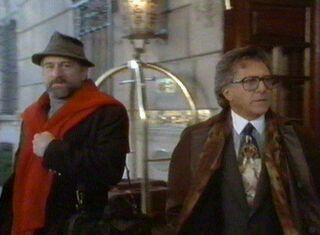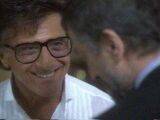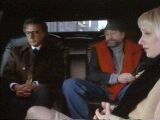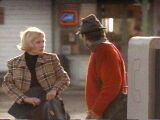 |
 |
When I saw this title for the first time, I thought "what does that mean wag the dog"? Although I know
I should admit that as I am a Japanese sometimes simply I may not understand even a simple phrase expressed in
English, even so I was quite sure that saying "wag the dog" was a very odd way of talking, and had to
have some metaphorical connotation. Then, metaphorically, what does that mean "wag the dog"? This question
is somewhat answered in the message shown in the introductory part of this movie. It says;
Why does a dog wag its tail?
Because a dog is smarter than its tail.
If the tail were smarter, the tail would wag the dog.
At this point, it becomes evident that the movie is about "A tail that wags the dog as a dog wags its tail";
i.e; about a preposterous arrangement (though I'm not so sure this is the right word for what I want to say). Then,
the next question will surely arise, namely what the words "tail" and "dog" metaphorically
represent. Before discussing this point, firstly I explain the plot, which is quite necessary.
The story has a political fixer played by Robert De Niro and his assistant Anne Heche. He is called for because
a sex scandal of the current president has been scooped just immediately before the next presidential election.
He hires a Hollywood producer played by Dustin Hoffman and let him produce a fabrication that the US and Albania
has entered into war state in order to distract the public attention from the sex scandal. Hoffman consolidates
the fabrication by backing up with such symbolic panaches as a folksong and a montage image that a young girl holding
a white cat is being chased by Albanian soldiers. But, CIA doesn't like it and intervene to make the none-existant
war over. Then, Hoffman fabricates another story that a solidier named Shoemann is left behind an enemy line and
make him a national hero by making a shoe-throwing performance a fashion. The next day the people all over the
America are doing this odd performance and patriotic emotion culminates overnight. When they bring this fictitious
soldier back to America, it turns out that the soldier to personify the hero is actually a demented convict played
by Woody Harrelson. And, as he goes berserk in the plane on the way back to Washington, the plane falls. So, they
continue to go back to Washington on land. But, on the way, Woody Harrelson is killed by a farmer because he has
tried to rape his daughter. For Hoffman, this isn't so bad a situation, because for him a tragic dead hero is better
than a hero coming back alive triumphantly. But, finally he makes a mistake by claiming his credit for everything
he has done, and is killed by Robert de Niro.
Firstly, I must stress the point that this "dog/tail" reversal metaphor is working quite in a multi-layered
fashion, and correspondently in our actual life of modern world, this sort of preposterous arrangement can be found
across various layers of seemingly ordinary modern life. Anyway, first of all, it's obvious that there has to be
a political satire in this movie because it concerns the image of the president of the United States, and hence,
the first reversal is the one between electorate and elected. Although we have to take into account the fact that
since the US government and, for that matter, many other countries' government are subject to representative government
system, electorate doesn't directly participate in the governmental decisions, it's strongly expected that the
general will of the electorate should be reflected in the will of the elected, and therefore, the most suitable
persons for representing the general will of the people should be elected as congressmen or the president. But,
in this movie's case, the roles are reversed and the president and his staff manipulate the electorate through
TV media, and create their own brand of public opinion to make the electorate believe that it is the authentic
general will of the public. In this regard, this movie cleverly point out the aspect that this kind of manipulation
can gain the maximum effect when it has been done with the effective use of symbolic manipulation. For example,
the president and his staff in this story not only create a false news that the US and Albania has entered into
war, but also they embelish the news with patriotic panaches such as folksongs and the image of gentle mother.
Especially, the folksong praising democracy sung in this movie is terrific. For, by this song, we can clearly see
how easily an abstract notion like democracy can be combined with emotional potentiality of the public using symbolic
representations such as folksongs. In this regard, one of the funniest scenes definitely concerns this symbolic
manipulation, where they fabricate a soldier named Shoemann who have unfortunately left behind the enemy line and
make a shoe-throwing performace a fashion overnight all over the America. Obviously, they take pains to elaborate
such a false story because they want to manipulate the people utilizing the powerful influence of symbolic representations
upon them through the osmotic power of TV media. Anyway, in this way, they are trying to raise the support rate
of the current president for the next president election by symbolic manipulation upon the people, and this is
quite preposterous, for, here, to be elected is deciding the general will of the electorate, not the other way
around. It can be easily seen that this is perfectly the opposite of the Abraham Lincoln's Gettysburg Address "government
of the people, by the people, for the people"; that is, "people of the government, by the government,
for the government". Here, the tail (to be elected or government) is wagging the dog (electorate or people).
The second reversal is the one between media and information. Essentially, the media is the way by which the information
is conveyed, and therefore it is called "media". But, in this movie's case, the media itself is creating
the information. The famous Sydney Lumet's movie "Network"(1970)
is the most eloquent depiction of this dangerous reversal. To the same degree as this famous title, "Wag the
Dog" depicts this reversal in a quite exaggerated way. For example, in this film, a movie producer played
by Dustin Hoffman is creating false information such as a war that doesn't actually exist; surely false information
but it becomes real for the audience once created by media. In this respect, even it can be said that since the
media governs every source of the information it handles, there won't be any standard by which the recipient can
judge whether a given bit of information supplied by the media is actually true or false. In other words, whereas
basically the veracity of the information a given media provides must assure the reliabily of that media, conversely
in this movie's case, the media itself is creating the veracity of the information it provides by governing all
the processes of information delivery. It should be well noticed that the simulated reality from the view point
of the media that provides it becomes actual reality when viewed from the view point of the recipient of that simulated
reality. In a word, the recipient who receives the information under certain rules (in this case, the rules mass
media defines) can determine the veracity of the information supplied by the media only according to the rules
that very media defines. In the last scene of this movie, Dustin Hoffman who claimed his credit for everything
he had done including the fabrication of the none-existant war between the US and Albania is killed by a political
wirepuller played by Robert de Niro. De Niro kills Hoffman because by claiming his credit, Dustin Hoffman at the
same time is claiming the exposure of this dangerous game, and once this kind of game is exposed, all the mechanisms
for creating the veracity of prefabricated information implimented by the media by whose power the illusion "simulated
reality is actual reality" can be produced will have to be exposed to the eyes of the recipient too, and that
is fatal for the media. That the media creats and manipulates the information and fabricates simulated reality
in order to manipulate the audience is complete reversal to the ideal that the media conveys the information in
order to communicate the facts and reality to the audience. Here, the tail (media) is wagging the dog (information)
as well as the tail (media) is wagging the dog (audience).
Considering in this way, we will soon be able to notice that there is another reversal surreptitiously functioning
in a more general layer; that is, the reversal between reality and fiction or fabrication. This means that, in
our age, it has become quite difficult to delineate a line between what is real and what is fiction. For exmple,
for those who are living in the world where the prefabricated reality created by media dominates, that very prefabricated
reality constitutes the reality itself as I described in the previous section. For, for them, there is no other
reality other than that. In a scene of this movie, Dustin Hoffman creates a fabricated event that a girl is attacked
by Albanian gunfire. He and his staffs tactfully assembles an image using montage technique combining an image
of a girl and an image of a battle field and an symbolic image of a white cat. But, this fabricated image becomes
a real image when viewed from the eyes of the audience who doesn't know the prefabrication process. This terrific
scene tells us that in our age reality has no absolute meaning and has become equivalent to what we deem to be
real or rather what we are allowed to deem to be real regardless of how it is constituted. Here, we can say that
the tail (fabrication) is wagging the dog (reality). In a special feature included in the VHS tape of this film,
a TV announcer concludes his interview saying "TV is reality". But, I think he should have said "TV
is reality, and now reality is TV".
Although you might think this movie is handling political satire considering the material, it goes beyond further
than that, and it is also handling the aspect of our age in a quite acerbic manner utilizing the form of black
comedy. To tell the truth, I think that this movie sometimes goes too far showing quite ludicrous scenes; such
as a scene where a captured soldier is trying to convey a message "courage mom" that is written on his
shirt with the Morse code or a scene where despite the fact that the plane they rode has been fallen to the ground,
still they (Robert De Niro and Dustin Hoffman and Anne Heche) are bickering each other with the crushed airplane
still being ablaze behind them. But, other than that, I like this movie very much, because in spite of the fact
that it depicts cynical political satire and includes very serious criticism against the mode of our age, it handles
them in quite a detached manner and with a very light touch as usual in other Barry Levinson's films. Besides,
it's quite refreshing to watch big stars like Robert de Niro and Dastin Hoffman playing together in this kind of
black but light political comedy satire. All in all, this is quite a terrific movie.


